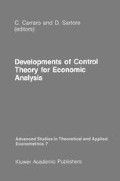Abstract
The object of the present note is to discuss some of the problems to be faced by an econometrician who wishes to simulate the impact of new control rules on an economy which has been operating in a different control environment. This discussion heavily relies on earlier work either on the specific issue of exogeneity, as analysed, e.g., in Engle et al. (1983), or on the more general issue of econometric modelling, as discussed, e.g., in Hendry and Richard (1982, 1983).
Access this chapter
Tax calculation will be finalised at checkout
Purchases are for personal use only
Preview
Unable to display preview. Download preview PDF.
References
Engle, R. F. (1984): “Wald, Likelihood Ratio and Lagrange Multiplier Tests in Econometrics”, Chapt. 13 in: Z. Griliches and M. D. Intriligator (eds.), Handbook of Econometrics, Vol. 2.
Engle, R. F., D. F. Hendry, and J. F. Richard (1983): “Exogeneity”, Econo-metrica 51, 277–304.
Florens, J. P. and M. Mouchart (1982): “A Note on Non-causality”, Econo-metrica 50, 583–592.
Florens, J. P. and M. Mouchart (1958a): “Conditioning in Dynamic Models”, Journal of Time Series Analysis 6, 15–34.
Florens, J. P. and M. Mouchart (1985b): “A Linear Theory for Non-causality”, Econometrica 53, 157–175.
Goodhart, C. A. E. (1973): “Monetary Policy in the United Kingdom”, Chap. 12 in: K. Holbick (ed.), Monetary Policy in Twelve Industrial Countries, Boston, Mass.; Federal Reserve Bank of Boston.
Goodhart, C. A. E. (1978): “Problems in Monetary Management: The U.K. Experience”, in: A. S. Courakis (ed.), Inflation, Depression and Economic Policy in the West: Lessons from the 1970’s, Oxford; Basil Blackwell.
Granger, C. N. J. (1969): “Investigating Causal Relations by Econometric Models and Cross-spectral Methods”, Econometrica 37, 424–438.
Hendry, D. F. and J. F. Richard (1982): “On the Formulation of Empirical Models in Dynamic Econometric”, Journal of Econometrics 20, 3–33.
Hendry, D. F. and J. F. Richard (1983): “The Econometric Analysis of Economic Time Series”, International Statistical Review 51, 111–163.
Holly, A. (1983): “A Simple Procedure for Testing Whether a Subset of Endogenous Variables is Independent of the Disturbance Term in a Structural Equation”, Cahiers de Recherches Economiques No. 836, Université de Lausanne, Switzerland.
Lubrano, M., R. G. Pierse and J. F. Richard (1986): “Stability of a UK Money Demand Equation: A Bayesian Approach to Testing Exogeneity”, The Review of Economic Studies 53, 603–637.
Lucas, R. E. (1976): “Econometric Policy Evaluation: A Critique”, in: K. Brunner and A. H. Melter (eds.), The Phillips Curve and Labor Markets, Carnegie-Rochester Conference Series on Public Policy 1, 19–46. North-Holland, Amsterdam.
Richard, J. F. (1980): “Models with Several Regimes and Changes in Exogeneity”, The Review of Economic Studies 47, 1–20.
Richard, J. F. (1984: “Classical and Bayesian Inference in Incomplete Simultaneous Equation Models”, in D. F. Hendry and K. F. Wallis (eds.), Econometrics and Quantitative Economics, 61–102, Basil Blackwell, Oxford.
Sims, C. A. (1980): “Macroeconomics and Reality”, Econometrica 48, 1–48.
Author information
Authors and Affiliations
Editor information
Editors and Affiliations
Rights and permissions
Copyright information
© 1987 Martinus Nijhoff Publishers, Dordrecht
About this chapter
Cite this chapter
Richard, J.F. (1987). Exogeneity and Control in Econometric Time Series Modelling. In: Carraro, C., Sartore, D. (eds) Developments of Control Theory for Economic Analysis. Advanced Studies in Theoretical and Applied Econometrics, vol 7. Springer, Dordrecht. https://doi.org/10.1007/978-94-009-3495-5_18
Download citation
DOI: https://doi.org/10.1007/978-94-009-3495-5_18
Publisher Name: Springer, Dordrecht
Print ISBN: 978-94-010-8063-7
Online ISBN: 978-94-009-3495-5
eBook Packages: Springer Book Archive

